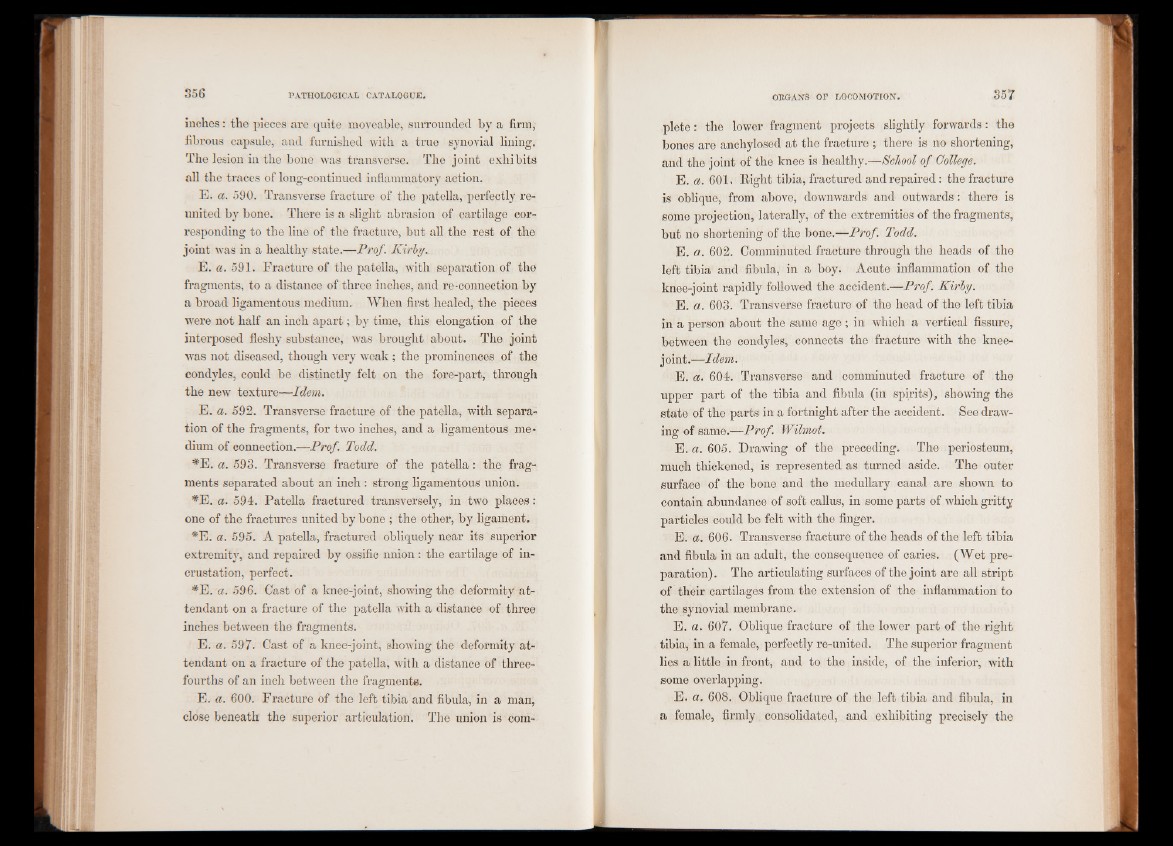
inches : the pieces are quite moveable, surrounded by a firm,
fibrous capsule, and furnished with a true synovial lining.
The lesion in the bone was transverse. The joint exhibits
all the traces of long-continued inflammatory action.
E. a. 590. Transverse fracture of the patella, perfectly reunited
by bone. There is a slight abrasion of cartilage corresponding
to the line of the fracture, but all the rest of the
joint was in a healthy state.—Prof. Kirby^
E. a. 591. Fracture of the patella, with separation of the
fragments, to a distance of three inches, and re-connection by
a broad ligamentous medium. When first healed, the pieces
were not half an inch apart ; by time, this elongation of the
interposed fleshy substance, was brought about. The joint
was not diseased, though very weak ; the prominences of the
condyles, could be distinctly felt on the fore-part, through
the new texture—Idem,.
E. a. 592. Transverse fracture of the patella, with separation
of the fragments, for two inches, and a ligamentous medium
of connection.—Prof. Todd.
*E. a. 593. Transverse fracture of the patella : the fragments
separated about an inch : strong ligamentous union.
#E. a. 594. Patella fractured transversely, in two places :
one of the fractures united by bone ; the other, by ligament.
*E. a. 595. A patella, fractured obliquely near its superior
extremity, and repaired by ossifie nnion : the cartilage of incrustation,
perfect.
#E. a. 596. Cast of a knee-joint, showing the deformity attendant
on a fracture of the patella with a distance of three
inches between the fragments.
E. a. 597. Cast of a knee-joint, showing the deformity attendant
on a fracture of the patella, with a distance of three-
fourths of an inch between the fragments.
E. a. 600. Fracture of the left tibia and fibula, in a man,
close beneath the superior articulation. The union is complete:
the lower fragment projects slightly forwards: the
bones are anchylosed at the fracture ; there is no shortening,
and the joint of the knee is healthy.—School of College.
E. a. 601. Right tibia, fractured and repaired: the fracture
is oblique, from above, downwards and outwards: there is
some projection, laterally, of the extremities of the fragments,
but no shortening of the bone.—Prof. Todd.
E. a. 602. Comminuted fracture through the heads of the
left tibia and fibula, in a boy. Acute inflammation of the
knee-joint rapidly followed the accident.—Prof. Kirby.
E. a. 603. Transverse fracture of the head of the left tibia
in a person about the same age; in which a vertical fissure,
between the condyles, connects the fracture with the knee-
joint.—Idem.
E. a. 604. Transverse and comminuted fracture of the
upper part of the tibia and fibula (in spirits), showing the
state of the parts in a fortnight after the accident. See drawing
of same.—Prof. Wilmot.
E. a. 605. Drawing of the preceding. The periosteum,
much thickened, is represented as turned aside. The outer
surface of the bone and the medullary canal are shown to
contain abundance of soft callus, in some parts of which gritty
particles could be felt with the finger.
E. a. 606. Transverse fracture of the heads of the left tibia
and fibula in an adult, the consequence of caries. (Wet preparation).
The articulating surfaces of the joint are all stript
of their cartilages from the extension of the inflammation to
the synovial membrane.
E. a. 607. Oblique fracture of the lower part of the right
tibia, in a female, perfectly re-united. The superior fragment
lies a little in front, and to the inside, of the inferior, with
some overlapping.
E. a. 608. Oblique fracture of the left tibia and fibula, in
a female, firmly consolidated, and exhibiting precisely the